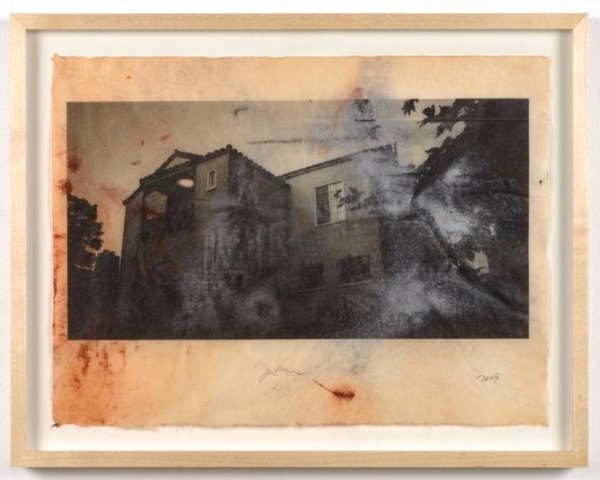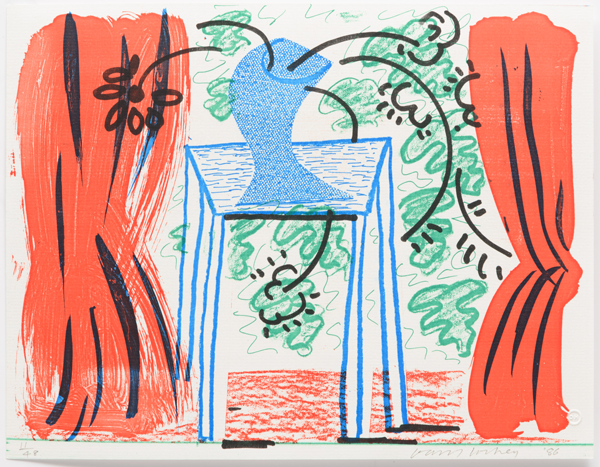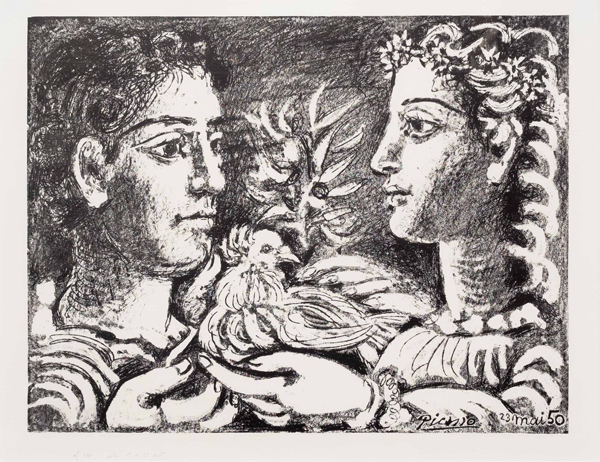"Friday Feature"
Joe Goode, David Hockney, Pablo Picasso, Andy Warhol
Leslie Sacks Contemporary
Bergamot Station 2525 Michigan Avenue, B6 Santa Monica, California 90404T: (310) 264-0640 F: (310) 264-0740 e-mail:


1 > 31 December, 2017

Joe Goode, Studies of the Past 60, 2009 Acrylic over archival digital print on Kozo paper, 12 x 16 inches, signed
I've always dealt with images that you could see through--usually glass, skies, clouds, or water. The "House" series from the 1960s was when I was just formulating this idea of being able to look through things. When you see a house or go by one of these very normal suburban homes, you instinctively know what's inside it because you've been in a thousand of them. And that's what really triggered this idea I had--even though you couldn't see through something, on some level you knew what was inside. One of the great things about Los Angeles is that it's so open and it's always been that way. I think that's because of the geography, where everything's spread out. Anybody could do anything here and it's one of the very few cities where a person can do something that would normally offend you but you can just pick up and move. You don't have to live with it. There's a freedom here that's been here since I first came, at least, and I don't think it's changed. People who don't live here--they think of a large town, and it's a large small town, is what it is.
--Joe Goode as told to David Muenzer, ArtForum, April 21, 2017
View additional works by Joe Goode--Joe Goode as told to David Muenzer, ArtForum, April 21, 2017

Joe
Goode

David Hockney, Still Life with Curtains, March 1986 Home made print executed on an office color copy machine 8 1/2 x 11 inches, edition of 48, signed and numbered
My own photographic experiments made me look into cameras and what they were really doing, making me realize that an office copying machine was a camera that confined itself to flat surfaces. It never attempts to depict space. That the machine is also a printing press we knew, but never regarded it as a good one.
Yet thinking about these machines for a while before I first played with them two things occurred to me: that there is no such thing as a copy and that there is no such thing as a "bad" printing machine. (Only bad printers).
Of course in an office, it is used for copying messages; the slight variations in the marks from one to the other is not noticed because the content of the readable message is what is important.
I began experimenting with a friend's machine in February of this year and within an hour realized my hunch was right. They were fascinating printing machines, indeed they were a totally new kind of printing that offered the artist new areas and possibilities...
The images are made like one makes any color print. Each separate color is drawn onto a separate piece of paper (as each color is printed separately in the machine). I had experimented with methods of making marks and how the machine "sees" them, discovering that some marks are more easily translatable by the machine than others--I assume one of the subjects of these prints is the joy of discovering a new medium.
--David Hockney, Home Made Prints, Waser Druck, Zurich, Switzerland, 1986
View additional works by David HockneyYet thinking about these machines for a while before I first played with them two things occurred to me: that there is no such thing as a copy and that there is no such thing as a "bad" printing machine. (Only bad printers).
Of course in an office, it is used for copying messages; the slight variations in the marks from one to the other is not noticed because the content of the readable message is what is important.
I began experimenting with a friend's machine in February of this year and within an hour realized my hunch was right. They were fascinating printing machines, indeed they were a totally new kind of printing that offered the artist new areas and possibilities...
The images are made like one makes any color print. Each separate color is drawn onto a separate piece of paper (as each color is printed separately in the machine). I had experimented with methods of making marks and how the machine "sees" them, discovering that some marks are more easily translatable by the machine than others--I assume one of the subjects of these prints is the joy of discovering a new medium.
--David Hockney, Home Made Prints, Waser Druck, Zurich, Switzerland, 1986

David
Hockney

Pablo Picasso, Youth, 9 June 1950, lithograph, 22 1/4 x 30 1/4 inches One of five proofs for the artist, apart from signed and numbered edition of 50, inscribed
Why didn't Picasso draw this scene (and his many hundred prints) directly on paper? Why did he print it as a lithograph? The medium of the print obviously enabled him to achieve a particular sensual quality he could not have gained in the drawing. His printers tell us that Picasso strove with passionate intensity for perfection in his prints, even in the cases where a single copy was to be made.
--Erich Franz, translated by John S. Southland, Involved Gazes: Picasso's Lithographic Art
Picasso Lithographs, Hatje Cantz, Graphikmuseum Pablo Picasso, Munster
Hatje Cantz Verlag, Germany, 2000, page 8
View additional works by Pablo Picasso
Pablo
Picasso









